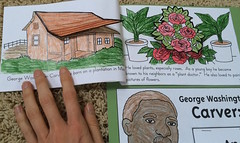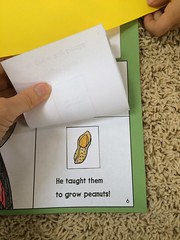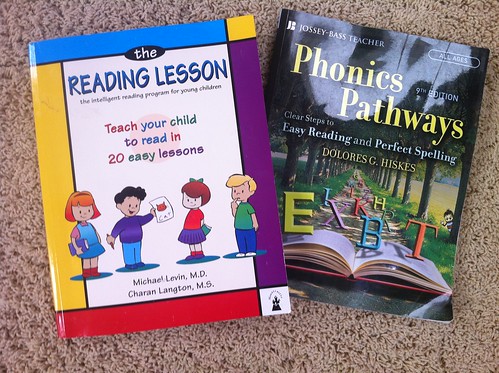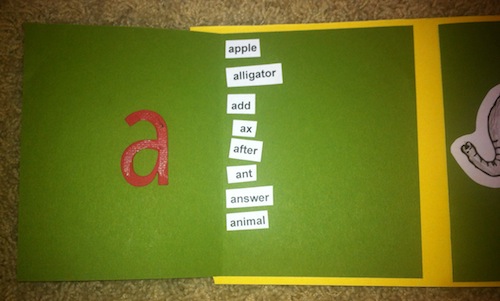

Last week he listened to the book Man’s Slave Becomes God’s Scientist: George Washington Carver. He loved it! George Washington Carver is just every boy’s best friend. After all, he escaped kidnapping; he got beat up and lived to tell about it; he was smarter than his teachers; and he loved dirt and bugs and all those boy kinds of things. That all aside, he makes for a worthy hero, so I love for my boys to admire worthy heroes. And he loved school, which is not a bad thing to encourage boys to love. (I said “boys” because actually others of us enjoyed the book, because we couldn’t escape it as it was being played over speakers loud enough for all of us to not be able to ignore, but fortunately we were all hooked.)
This was a total rabbit trail, and has nothing to do with any of our curriculum, but while we were on a role, we also checked out a book about George Washington Carver for younger kids: A Weed Is a Flower : The Life of George Washington Carver by Aliki and read that. That is a super well illustrated little book that I had read to my older kids once upon a time, and just had to read it again.
Rabbit trail or no, Ace did a notebook page about George Washington Carver and if you ask him to tell you stories, you’d better sit down because it’s going to take awhile. Here are a few of pictures.

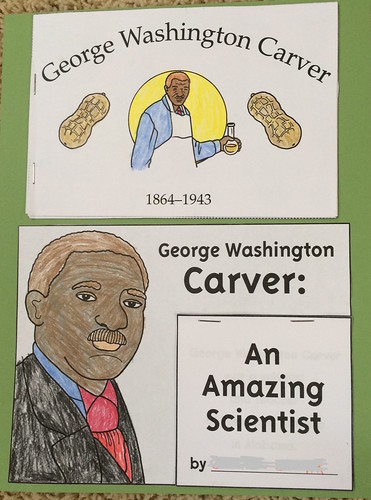
List of resources:
Hold That Thought World & US History Notebook Pages (Out of Print) (George Washington Carver Notebook Page)
U.S. History Little Books: Famous People — George Washington Carver (Free) (George Washington Carver 1864-1943 Mini Book)
Literacy-Building Booklets: Famous Americans (An Amazing Scientist Mini Book)
Man’s Slave Becomes God’s Scientist: George Washington Carver (Audio Book) (Sad to see that the price has gone up.)
A Weed Is a Flower : The Life of George Washington Carver (Well illustrated children’s book about Carver.)
Phonics Programs—The Reading Lesson
I’m working on phonics with my third child. I know that doesn’t make me a pro, by any means, but I do feel like I’ve been around this bush before. I have purchased so many phonics programs, that it’s ridiculous. Let’s see, right off, I can think of: Writing Road to Reading, The Reading Lesson, Phonics Pathways, Explode the Code, First Language Lessons for a Well-Trained Mind, and Teach Your Child to Read in 100 Easy Lessons and that doesn’t count a couple of game based programs that I have.
If you are aghast that I purchased so many programs, don’t worry, I am too. (And my husband is going to learn from my blog post how many I’ve purchased, so I’ll have a little explaining to do.) The only thing I can say to defend myself is that I actually did try every single one. If you’re wondering how in the world I managed to try that many programs on so few children, I don’t know. One of my children was slow about learning to read, so I had the chance to try out a bunch of stuff on that one, I guess.
So are you curious which program I chose to use this round? I chose The Reading Lesson, which, believe it or not, is the very first program that I purchased. Sigh. I waisted a bunch of money.
Here is my short list of reasons why I returned to The Reading Lesson.
- It’s simple.
It doesn’t incorporate classical education or writing or even spelling. It’s just phonics. But neither does it have pages and pages of instructions for the teacher. It’s just simple and self-explanatory.
- It has simple illustrations.
I found that some of the others that I tried had no illustrations (Writing Road to Reading and First Language Lessons) and that my kids actually are more engaged with simple illustrations. I also found that the illustrations in Explode the Code were distracting for my kids. It seems that The Reading Lesson has found a nice balance between no illustrations and wild and crazy illustrations.
- It has simple stories starting in the second lesson.
This has turned out to be the biggest factor in my choosing this program. I’m fine with the stories and my kids are happy with the stories. Teach Your Child to Read in 100 Easy Lessons had too goofy of stories for me. Writing Road to Reading had no stories. First Language Lessons had stories that bored my kids. They always complained about the stories. Phonics Pathways had too few stories. They were always complaining that they wanted to read something real, not just a bunch of words. I realize I can use readers for stories, and we do use readers. We have Dick and Jane stories and we have easy Bible story readers and more. But having a simple story in the phonics program helps my kids want to not just use readers, but use the phonics program too. If it works and my kids are happy at the same time, then I’m happy too!
I have learned a little bit from teaching reading to my older two. One is that all the programs are almost alike. There are slight variations which the authors tout as making theirs far superior to the others, but they are basically alike. For a child who is ready to learn to read, any program will work. The ones written by people with their Ph.D. and the ones written by homeschool moms who have had three dozen children will all work, if your child is ready. Nonetheless, I think I’ve found my favorite, and beings that I have one to teach reading to now and a preschooler that will need to learn reading in a few years, I’m happy to have one program and stay with it and not try out anymore.
Short Vowels
G’tums was having trouble remembering which vowel made which sound, so we decided to do a little project that was fun and now he has them mastered.
We cut off the bottom of a file folder and glued in these little cards. He cut out and colored the clip art on the front which was taken from the Dinah Zike Line Art Library. He punched out the letters on my Big Shot. And he cut out the words that I typed that began with the short vowel sounds and glued them into the corresponding mini book.
This project was adapted from an idea in the book: Foldables and VKVs® for Phonics, Spelling, and Vocabulary PreK-3rd by Dinah Zike.
